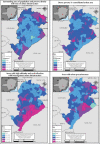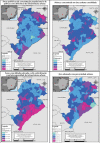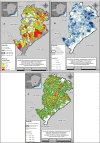ArboAlvo: stratification method for territorial receptivity to urban arboviruses
- PMID: 35649086
- PMCID: PMC9126578
- DOI: 10.11606/s1518-8787.2022056003546
ArboAlvo: stratification method for territorial receptivity to urban arboviruses
Abstract
Objective: To present the urban arboviruses (dengue, zika and chikungunya) stratification methodology by the territorial receptivity Index, an instrument for the surveillance and control of these diseases, which considers the heterogeneity of an intra-municipal territory.
Methods: Ecological study that uses as unit of analysis the areas covered by health centers in Belo Horizonte. For the development of a territorial receptivity index, indicators of socio-environmental determination of urban arboviruses were selected in order to integrate the analysis of main components. The resulting components were weighted by the analytic hierarchy process and combined via map algebra.
Results: The territorial receptivity index showed great heterogeneity of urban infrastructure conditions. The areas classified with high and very high receptivity correspond to approximately 33% of the occupied area and are mainly concentrated in the administrative planning regions of East, Northeast, North, West, and Barreiro, especially in areas surrounding the municipality. When the density of dengue cases and Aedes eggs, from 2016, were superimposed with the stratification by the index of territorial receptivity to urban arboviruses, areas of very high receptivity had a high density of cases and Aedes eggs - higher than that observed in other areas of the city, which corresponds to a very small percentage of the municipal territory (13.5%).
Conclusion: The analyses indicate the need for the development of adequate surveillance and control actions for each context, overcoming the logic of homogeneous allocation throughout the territory.
OBJETIVO: Apresentar a metodologia de estratificação das arboviroses urbanas (dengue, zika e chikungunya) pelo índice de receptividade territorial, instrumento de vigilância e controle dessas doenças que considera a heterogeneidade territorial intramunicipal.
MÉTODOS: Estudo ecológico que utiliza como unidade de análise as áreas de abrangência dos centros de saúde de Belo Horizonte (MG). Para a construção do índice de receptividade territorial foram selecionados indicadores de determinação socioambiental das arboviroses urbanas a fim de integrar à análise de componentes principais. As componentes resultantes foram ponderadas por análise de processos hierárquicos e agregadas por meio de álgebra de mapas.
RESULTADOS: O índice de receptividade territorial evidenciou grande heterogeneidade das condições de infraestrutura urbana. As áreas classificadas como alta e muito alta receptividade correspondem a aproximadamente 33% da área ocupada e se concentram sobretudo nas regiões de planejamento administrativo Leste, Nordeste, Norte, Oeste e Barreiro, principalmente em áreas limítrofes do município. Quando sobrepostas à densidade de casos de dengue e de ovos de Aedes em 2016, a estratificação pelo índice de receptividade territorial às arboviroses urbanas demonstra que áreas de muito alta receptividade apresentam uma densidade de casos, bem como de ovos de Aedes superior àquela observada nas demais áreas da cidade, o que corresponde a um percentual bastante reduzido do território municipal (13,5%).
CONCLUSÕES: As análises indicam a necessidade do desenvolvimento de ações de vigilância e controle adequadas para cada contexto, superando, assim, a lógica de alocação homogênea em todo o território.
Conflict of interest statement
Figures






References
-
- Honório NA, Câmara DCP, Calvet GA, Brasil P. Chikungunya: uma arbovirose em estabelecimento e expansão no Brasil Cad Saude Publica. 2015;31(5):906-8. https://doi.org/10.1590/0102-311XPE020515 - PubMed
-
- Zanluca C, Melo VC, Mosimann ALP, Santos GIV, Santos CND, Luz K. First report of autochthonous transmission of Zika virus in Brazil. Mem Inst Oswaldo Cruz. 2015;110(4):569-72. https://doi.org/10.1590/0074-02760150192 - PMC - PubMed
-
- Bhatt S, Gething PW, Brady OJ, Messina JP, Farlow AW, Moyes CL, et al. The global distribution and burden of dengue. Nature. 2013;496(7446):504-7. https://doi.org/10.1038/nature12060 - PMC - PubMed
-
- Beatty ME, Beutels P, Meltzer MI, Shepard DS, Hombach J, Hutubessy R, et al. Health economics of dengue: a systematic literature review and expert panel’s assessment. Am J Trop Med Hyg. 2011;84(3):473-88. https://doi.org/10.4269/ajtmh.2011.10-0521 - PMC - PubMed
-
- Ministério da Saúde (BR). Boletins Epidemiológicos. Brasília, DF; 2016 [cited 2020 Sep 9]. Available from: https://www.gov.br/saude/pt-br/assuntos/boletins-epidemiologicos
MeSH terms
LinkOut - more resources
Full Text Sources
Medical

